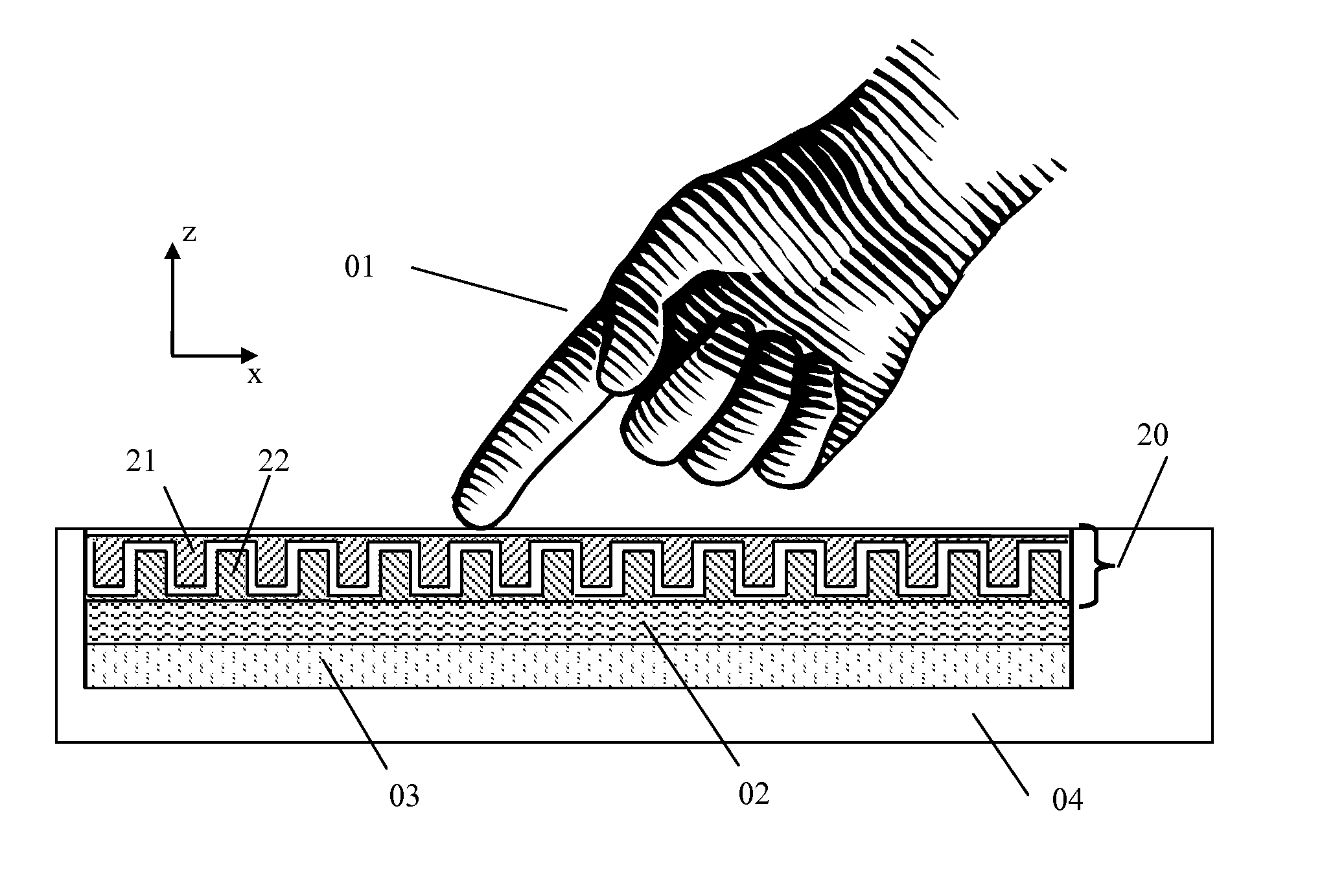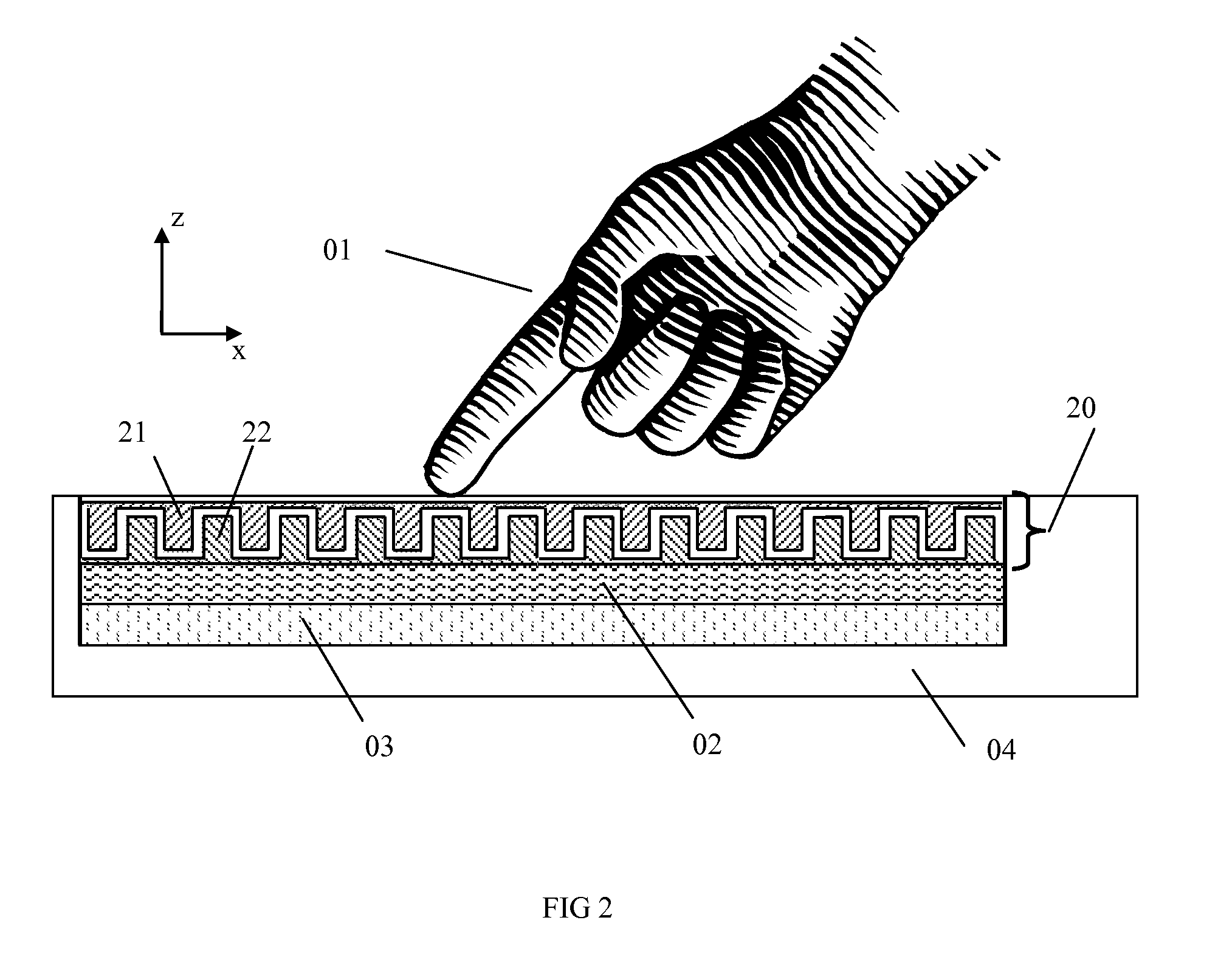Touch-screen device including tactile feedback actuator
a technology of tactile feedback and touch screen, applied in the field of touch screen devices, can solve the problems of increased data entry error rates, decreased user satisfaction, and insufficient transparency of pressurized fluid devices
- Summary
- Abstract
- Description
- Claims
- Application Information
AI Technical Summary
Benefits of technology
Problems solved by technology
Method used
Image
Examples
first embodiment
[0103]The detailed structure of the tactile feedback actuator 20 is shown in FIG. 3 and FIG. 4A. A plurality of first ridges 23a are formed on the bottom of the first substrate 21 and a plurality of complementary second ridges 23b are formed on the top of the second substrate 22. The ridges 23a,23b may be formed, for example by plasma etching a suitably masked sheet of organic polymer or glass or other transparent material serving as a substrate as described in Plasma Deposition, Treatment, and Etching of Polymers (ed. Riccardo d'Agostino) chapter 5 and is known in the science of liquid crystal display manufacturing. The reader will be aware that there are other methods by which ridges can be formed, for example, by simple milling of the surface, or by chemical etching. Alternatively the ridges can be built up on a planar surface.
[0104]The tactile feedback actuator 20 includes an electrode arrangement formed on the first and second substrates. More particularly, one or both side wa...
second embodiment
[0114]In this invention, a pulse of either positive or negative potential is applied to one electrode set (e.g. 42) of a first pair 35a to generate the time-varying potential difference across the respective electrode sets and resultant electrostatic force of attraction between the two electrode sets forming the pair. (In other words, one electrode set of the first pair 35a receives a voltage pulse whilst the other electrode set of the first pair 35a remains at a fixed potential such as the system ground.) The return motion is generated by repeating this operation on one electrode set (e.g. 43) of the other electrode pair 35b. (In other words, one electrode set of the second pair 35b receives a voltage pulse whilst the other electrode set of the second pair remains at a fixed potential such as the system ground). This is shown in FIG. 7. In State 1, V3 is at ground potential and V2 has a potential pulse applied to it (V1 and V4 are both at ground potential). This causes attraction b...
fourth embodiment
[0116]FIG. 9A shows this invention in which elastic spacers 55 are used to return the first substrate 21 to equilibrium position relative to the second substrate 22. Electrostatic forces created by the time-varying potential difference are used still to cause the initial motion, but the return force is provided by the elastic spacer 55 so as to result in the oscillatory lateral movement. The elastic spacers 55 are positioned between the moving substrate 21 and the supporting frame 56. The reader will be aware that this is not the only position at which elastic spacers 55 can be placed to cause the return force. In an alternative arrangement to this embodiment, shown in FIG. 9B, an elastic seal 57 is placed around the edge of the first substrate 21. The elastic seal57 functions like the elastic spacers 55 in serving to return the first substrate to an equilibrium position relative to the second substrate following lateral motion due to the electrostatic force created by the time-vary...
PUM
 Login to View More
Login to View More Abstract
Description
Claims
Application Information
 Login to View More
Login to View More - R&D
- Intellectual Property
- Life Sciences
- Materials
- Tech Scout
- Unparalleled Data Quality
- Higher Quality Content
- 60% Fewer Hallucinations
Browse by: Latest US Patents, China's latest patents, Technical Efficacy Thesaurus, Application Domain, Technology Topic, Popular Technical Reports.
© 2025 PatSnap. All rights reserved.Legal|Privacy policy|Modern Slavery Act Transparency Statement|Sitemap|About US| Contact US: help@patsnap.com



